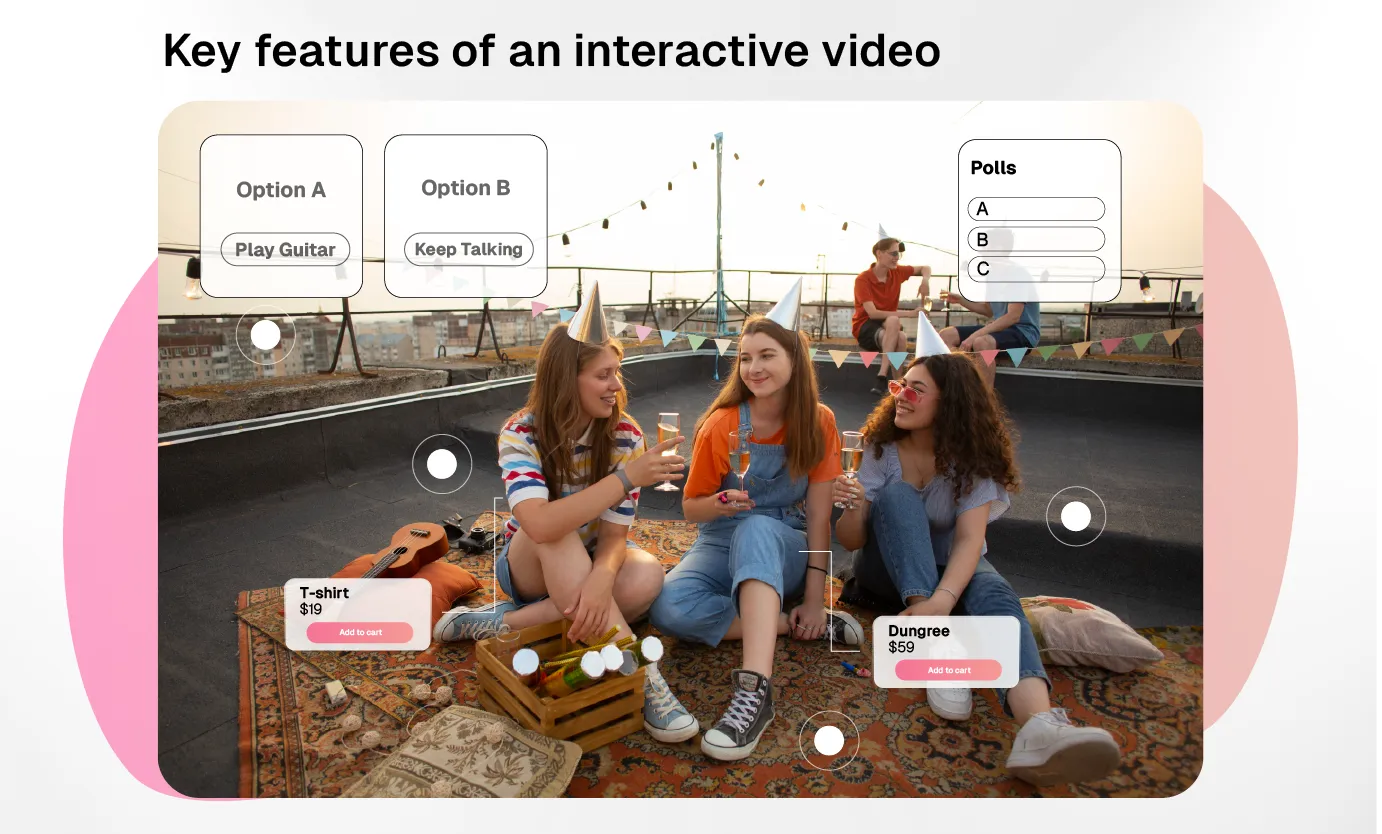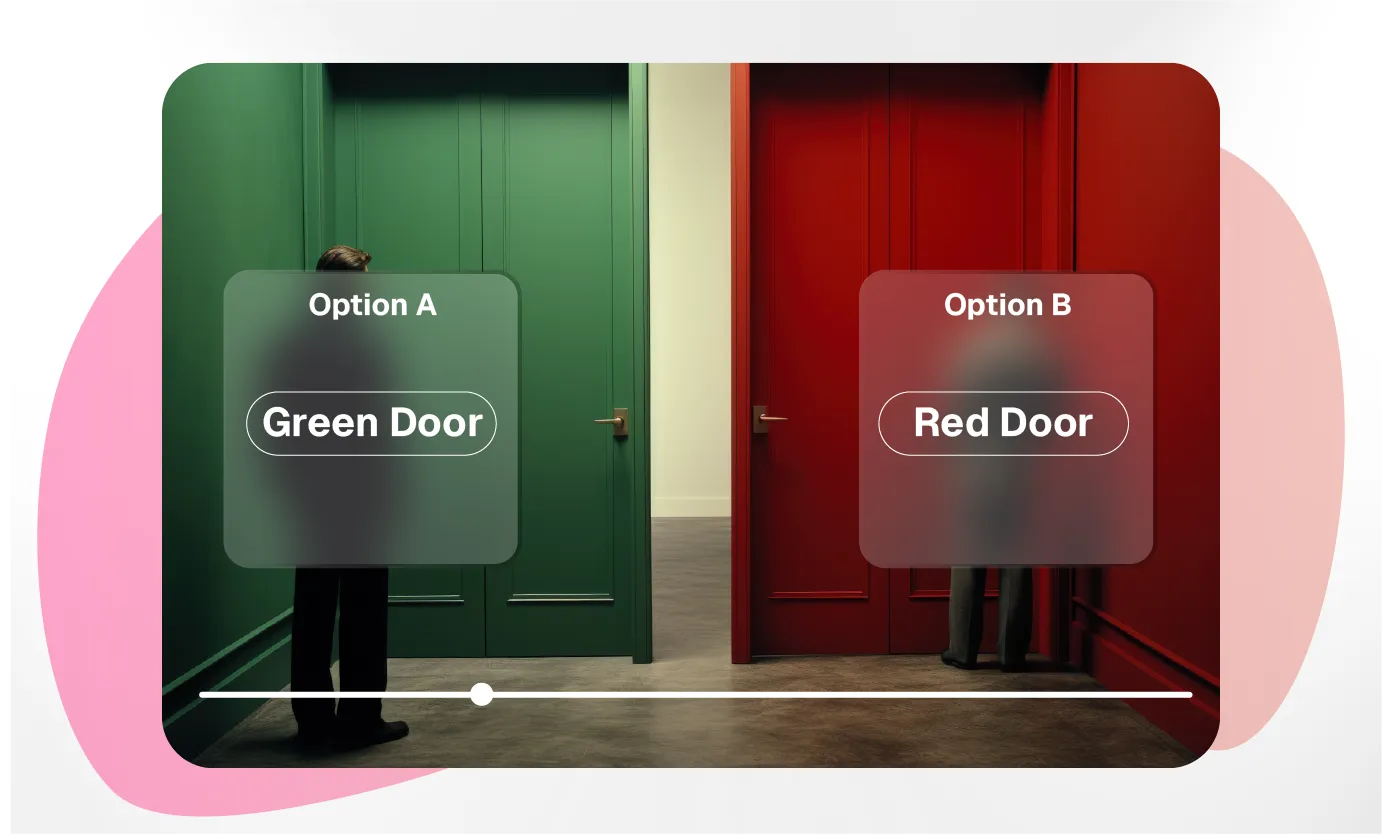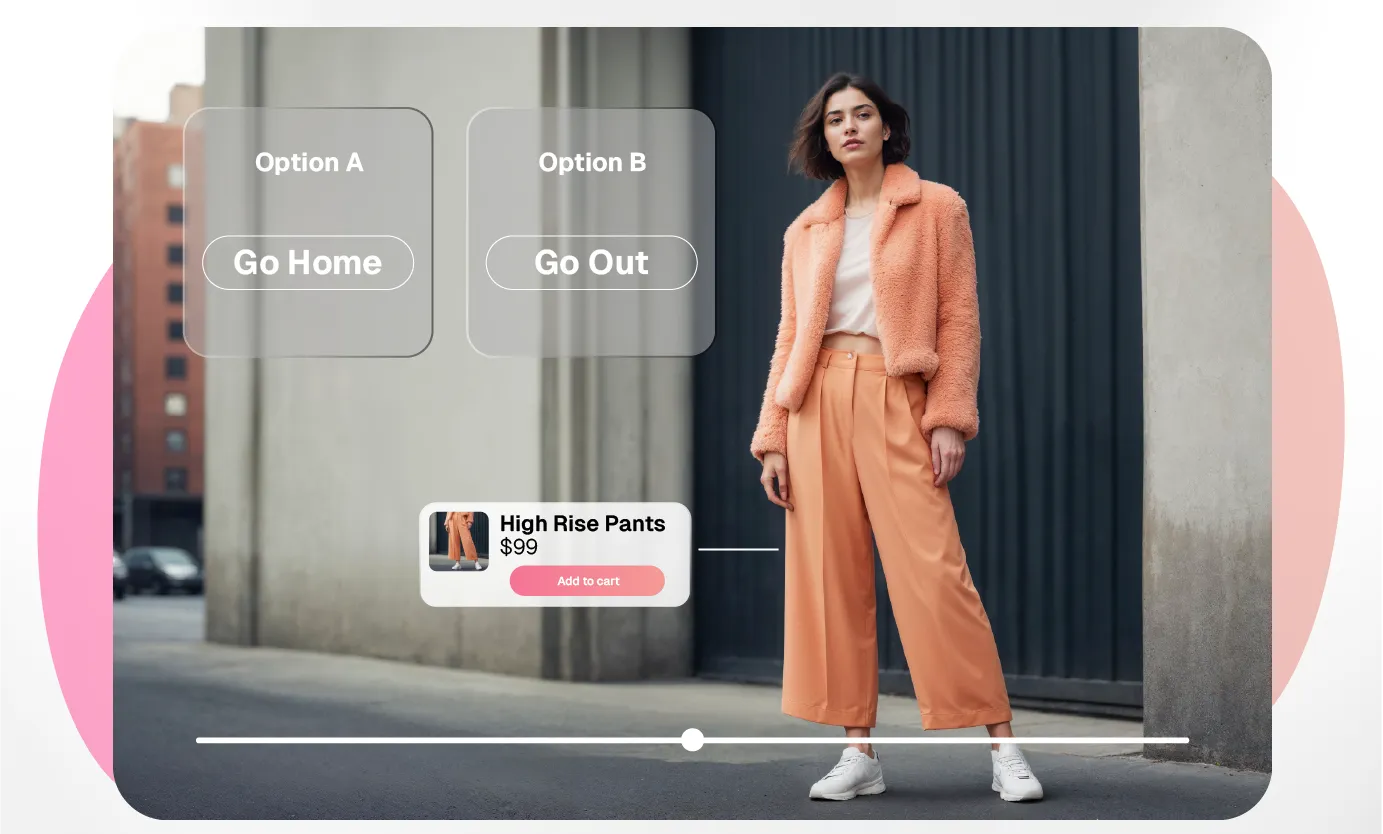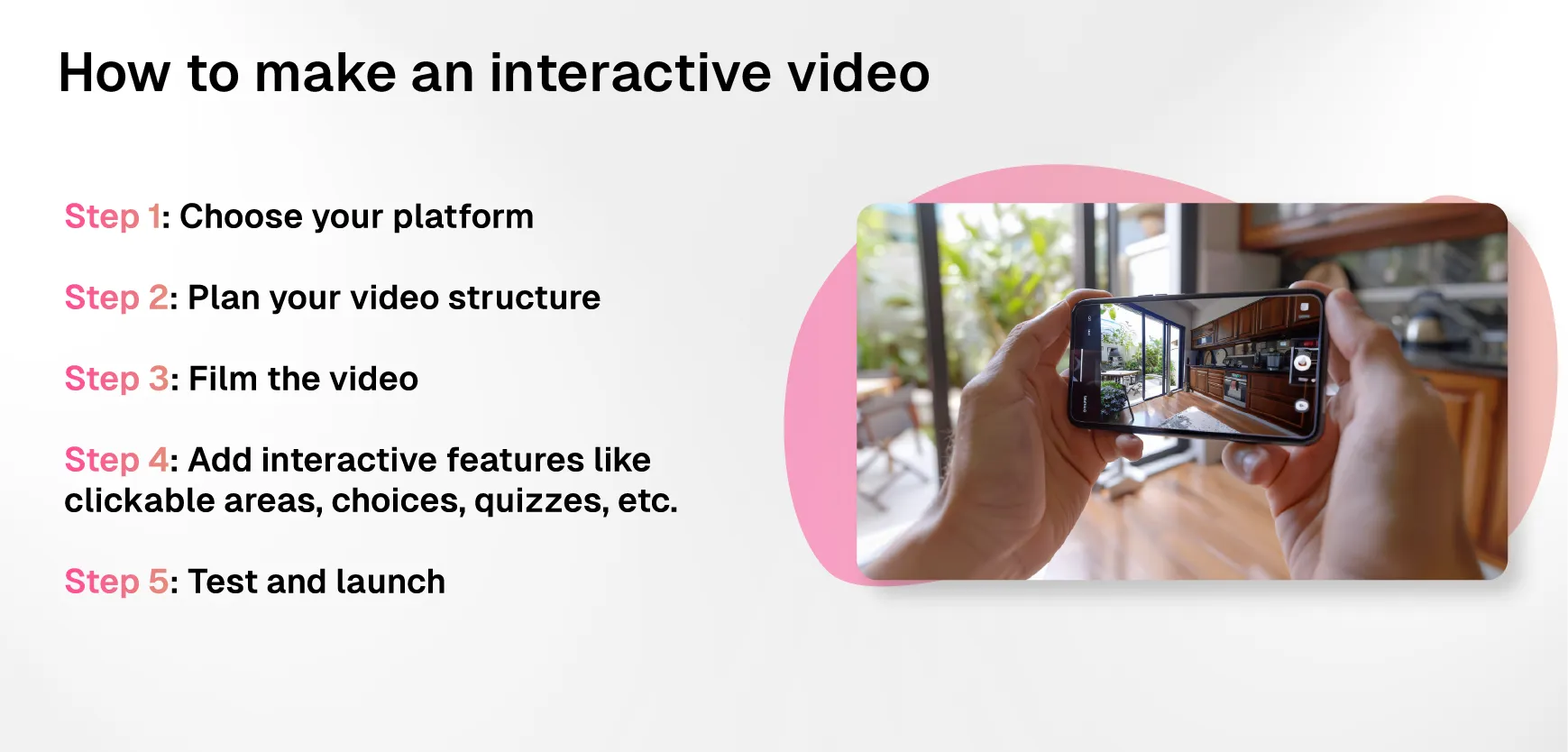Interactive video isn’t just another way to watch- it's a fully immersive experience where you call the shots. Instead of passively watching a story unfold, you engage directly with the content. Click on products to see more details, choose different story paths, or even shop right from the video. This approach transforms a one-way narrative into a dynamic, personalised journey that feels tailor-made for you. It’s the future of digital storytelling and commerce—engaging, intuitive, and built for today’s active viewers.
Interactive content has been gaining significant traction in recent years. Consider these statistics by Worldmetrics.
- 81% of marketers say that interactive content, like videos, grabs attention more effectively than static content.
- More than 60% of viewers engage with interactive content, and these viewers are more likely to convert into customers compared to those who watch traditional videos.
- Interactive video content can generate a 2x-3x higher click-through rate compared to static content, showing how effective it can be in grabbing attention.
Before we get into how you can use it to grow your brand, let's look at what makes it different for a traditional video.
What is an interactive video?
Interactive videos let you do more than just sit back and watch—they invite you to take part. In a typical video, you press play and follow a set path. You can click on parts of the screen to discover extra details, make choices that affect the story, or explore topics deeper without ever leaving the video.
Imagine watching a product showcase where you can tap on an item to see its features or answer a quick poll that tailors the content to your interests. It’s about transforming a passive viewing experience into an engaging, hands-on journey.
What are some features of an interactive video?
Interactive videos come packed with features that boost engagement and drive action. Some of these key features are-

- Clickable Hotspots- These are specific areas in the video that you can click to get more information. Picture a car commercial where clicking on the engine, tires, or interior brings up detailed sub-videos or specs.
- Branching Scenarios- Much like a “choose-your-own-adventure” book, you make decisions that shape the next part of the video. For instance, in a travel video, you might choose between two destinations, and the video adapts to show content based on your pick.
- Quizzes and Polls- These let you interact directly by answering questions or taking part in polls, creating a more personalised viewing experience.
- Shoppable Elements- Especially popular in e-commerce, this feature lets you click on a product and get taken straight to its page or add it to your cart. It cuts out extra steps, making shopping as easy as a click.
This is what they look like-
Ever watched Netflix’s "Black Mirror: Bandersnatch"?While not directly related to e-commerce, Netflix’s Black Mirror: Bandersnatch is a brilliant example of interactive storytelling. The film allowed viewers to make decisions for the main character, which would change the story's direction. The result? Multiple possible endings depending on the viewer’s choices.
How does an interactive video work?

An interactive video integrates additional layers of functionality over the standard video format. These layers are built using various tools and technologies that allow viewers to click, make choices, or interact with objects on the screen without pausing the video or leaving the platform.
Most interactive video platforms—like Whatmore, Wirewax, or Wideo—offer user-friendly interfaces where content creators can upload a video and overlay interactive features like buttons, hotspots, and product links. The final result is a seamless experience where users can engage with the content without interrupting the flow of the video. (See how to create videos for your business)
These videos empower the viewer, making them an active participant rather than a passive observer. By allowing the audience to engage directly with the content, brands can create a more memorable experience, leading to higher engagement, increased time spent on site, and, ultimately, better conversion rates.
How can they help e-commerce stores?
Interactive videos are more than just a fun way to watch content; they can be powerful tools for e-commerce stores.

By turning viewers into active participants, these videos can increase engagement, simplify the shopping experience, and ultimately drive more sales. Here's how they can make a difference for online stores:
1. Enhanced engagement
Interactive videos grab attention because they invite viewers to do more than just watch. They can click on products, explore features, or even make choices that change the flow of the video. This level of involvement keeps people interested for longer periods, increasing the time they spend with your brand.
For example, imagine a fashion retailer showing off a new collection in an interactive video. As the models walk down the runway, viewers can click on each outfit to see more details, like price and available sizes. Instead of just watching the clothes, customers can actively explore them, making the shopping experience much more engaging.
2. Simplifying the path to purchase
With interactive videos, you can remove the extra steps between a customer seeing a product and buying it. Instead of having to search for a product after watching a video, viewers can click on it directly in the video and add it to their cart or buy it on the spot.
3. Helping customers explore products
Interactive videos are perfect for showcasing complex products or multiple product variations. They give customers a chance to see different features, colours, or sizes without leaving the video. This is particularly helpful for items that need extra explanation or visual examples.
4. Creating a personalized shopping experience
Interactive videos can also offer a more personalised experience by letting viewers choose what they want to see. This means each viewer can have a unique journey based on their preferences, which helps create a stronger connection between the customer and the brand.
For instance, Asos created an interactive video where viewers could pick outfits for a model by selecting different clothing options. This “choose-your-own-adventure” style video allowed customers to create looks that matched their personal style, giving them a sense of control and personalisation.
5. Increasing conversion rates
Interactive videos streamline the shopping process, making it easier for customers to move from interest to purchase. By allowing viewers to interact with and buy products directly within the video, brands can reduce the steps it takes to complete a purchase, leading to higher conversion rates.
For example, Zara launched an interactive product lookbook where customers could click on clothing items in the video to view details and buy them directly. This eliminated the need for viewers to navigate away from the video, making it more likely that they would follow through with their purchases.
Interactive videos help e-commerce stores by making the shopping experience more engaging, personalised, and faster. They offer a new way for brands to connect with customers, and by allowing viewers to explore and buy products seamlessly, they can lead to higher sales and customer satisfaction.
How to make an interactive video (including shoppable features)
Creating an interactive video might sound challenging, but it’s easier than you think. Here’s a quick step-by-step guide:

- Choose your platform: First, decide which platform to use for creating your interactive video. There are various tools available like Shoppable, Wideo, and Wirewax, which allow you to add interactive elements without requiring technical expertise.
- Plan your video structure: Before shooting, plan the interactive elements. Will viewers be able to click on products? Will they make choices that affect the video’s flow? Outline these elements so they can be incorporated during the filming and editing stages.
- Film the video: Keep in mind where the interactive elements will go. For example, if you're showcasing a product, leave enough time and space in the video for pop-up information or clickable buttons.
- Add interactive features: Once your video is ready, upload it to your chosen platform. Here, you can add interactive features like clickable areas, product links, forms, quizzes, and more.
- Test and launch: After adding the interactive elements, test the video thoroughly. Make sure that all clickable areas work well and that the user experience is smooth. Once everything is working, launch the video on your website or social media platforms.
Pro tip- Platforms like Whatmore.ai allow you to directly embed purchase links in your video, making it incredibly easy for customers to buy what they see.
10 best examples of e-commerce interactive videos
1. Nike Air Max Dia “Style It Yourself” interactive film
The Nike Air Max Dia “Style It Yourself” interactive film is an innovative example of how fashion brands can engage audiences by making them active participants in the creative process. In collaboration with fashion influencer Barbara Malewicz, Nike created this interactive video to allow viewers to style their own outfits featuring the Nike Air Max Dia sneakers.
As viewers watch the video, they can click on various clothing items, shoes, and accessories worn by the models to mix and match different looks. This interactive experience gives users the chance to become their own stylists, experimenting with different combinations to create their preferred outfits. The concept of “Style It Yourself” not only promotes the sneakers but also enhances the shopping experience by letting customers visualize how the Air Max Dia would fit into their personal wardrobe.
This format is especially appealing to fashion-conscious consumers who enjoy the idea of curating their own looks. It also helps Nike showcase the versatility of the Air Max Dia in a fun and engaging way, turning a product showcase into an interactive style guide.
You can check out the interactive film and explore the styling options yourself at Nike Air Max Dia Interactive Film.
2. IKEA's "Bedroom Habitats"
IKEA's "Bedroom Habitats" interactive video, created in partnership with Wirewax, is an excellent example of how brands can use technology to enhance the shopping experience. This interactive video aimed to showcase IKEA's bedroom solutions in a more engaging and personalized way. Rather than a simple walkthrough of products, IKEA gave users the ability to explore various bedroom setups and interact with individual items within those environments.
Viewers could click on different parts of the room—such as the bed, wardrobes, or storage units—to learn more about each item while watching the video. They could also add products to their shopping cart directly from the video, making the path from inspiration to purchase much shorter and smoother.
This way, IKEA allowed customers to experience their bedroom furniture in a more immersive way, essentially turning the video into a virtual showroom.
See how this worked:
3. NTT Data corporate holiday video
NTT Data corporate holiday video
The NTT Data corporate holiday video is a delightful interactive experience that turns a traditional holiday greeting into something engaging and fun. This video allows viewers to interact with various elements throughout the video, making the greeting more personalised and entertaining. As you watch, you can click on different sections of the video to explore hidden features, such as selecting holiday-themed gifts, watching special messages, or participating in fun holiday-themed games. This lets you view the products subtly without taking the focus away from the Holiday greetings.
By incorporating interactive features, NTT data demonstrates how even corporate communication, often seen as formal or generic, can become a creative and enjoyable experience.
4. Nike’s “You Can’t Stop Us” interactive campaign
Nike’s "You Can’t Stop Us" is a powerful example of how interactive videos can create both emotional impact and engagement. Released in 2020, this ad is part of Nike's broader campaign that highlights determination, diversity, and the idea of collective strength in the face of challenges. The video features split-screen editing that compares athletes from various sports and backgrounds, showing how they all move and strive in similar ways despite their differences.
What made this campaign especially engaging was the interactive version, where viewers were able to remix the video with their own. Nike provided users with tools to make their own custom versions by selecting different video clips and text to create a personalized experience. This level of interactivity empowered viewers to become co-creators, making them feel more connected to the message and to the brand.
For example, users could pick the clips that resonated most with them, and by assembling their own versions of the ad, they participated in spreading the message of unity and resilience. This not only increased engagement but also helped Nike build a sense of community around their brand.
5. Macys and H&M
Macy's and H&M collaborated on a unique interactive experience using Adventr's platform. This video, designed to engage viewers on a deeper level, introduced voice-activated technology to enhance the interactive element. By incorporating voice commands, users could interact with the video in real time, navigating through different sections, exploring products, and customizing their journey based on their preferences.
As the video progresses, users are asked to make choices through their voice or clicks, which then directs them to specific product categories or styles. For instance, when prompted to choose between various clothing styles or categories, viewers can verbally respond, and the video adjusts accordingly. This creates a more immersive and personalised experience, allowing users to explore H&M’s offerings in a dynamic way.
This innovative approach allows users to feel more in control of their journey, making it easier to explore products and make purchasing decisions directly within the video.
6. Lifesaver interactive film
The Lifesaver Interactive Film is an award-winning project designed to teach viewers how to perform CPR and respond to life-threatening emergencies, like cardiac arrest. What sets this film apart is its interactivity, which places viewers in the role of a first responder during a crisis. Developed by the UK Resuscitation Council, this film is not just something you watch—it's something you participate in, with your decisions impacting the outcome.
Throughout the film, viewers are prompted to make real-time decisions on how to handle emergency situations, such as whether to perform CPR, how to use an Automated External Defibrillator (AED), and when to call for help. By engaging viewers in these critical moments, the film creates a more memorable and impactful learning experience than traditional educational videos.
The film presents scenarios that allow the viewer to practice their decision-making skills, making it an immersive learning tool. The combination of high-stakes situations, realistic characters, and interactive choices enhances both knowledge retention and practical skills. It effectively turns education into a "game" where your quick decisions can save lives, providing immediate feedback on the choices you make.
This format has been praised for its effectiveness in educating the public on CPR techniques, with research showing that interactivity increases the likelihood of viewers remembering the critical steps involved in saving someone’s life.
You can experience the interactive film on the official Lifesaver platform- Lifesaver Interactive Film.
7. Nespresso
The Nespresso Interactive Video, powered by Wirewax, offers a fun and immersive experience for coffee lovers. This isn't your typical video ad—it's an engaging journey where you can explore Nespresso’s products in a hands-on way, right from your screen.
As the video unfolds, viewers can click on different elements—whether it's a sleek coffee machine or a variety of coffee capsules—to instantly get more information. It’s like browsing a virtual Nespresso store where everything you want to know is just a click away.
Nespresso’s use of interactivity isn’t just about showcasing their products; it’s about creating a fun, memorable shopping journey. It eliminates the usual friction of online shopping by letting you explore, learn, and shop seamlessly—all within a beautifully crafted video.
8. Mindstamp interactive co working space tour
Mindstamp interactive coworking space tour an excellent example of how interactive videos can transform a simple tour into an engaging, user-driven experience. In this video, users can explore various parts of a co-working space at their own pace, making it more than just a walkthrough. By clicking on hotspots throughout the video, viewers can get detailed information about different areas, such as private offices, meeting rooms, and shared workspaces.
What sets this tour apart is its ability to provide a personalised experience. For example, if you're interested in learning more about the amenities, like the kitchen or lounge areas, you can click on those specific sections. This level of interaction helps potential clients explore the space in a way that suits their interests, creating a more engaging and informative experience than a traditional video.
Additionally, the video includes prompts and questions to gather feedback or provide further details about pricing, availability, and membership options. This feature helps convert interest into action, as viewers can quickly get the information they need to make a decision.
9. Vimeo interactive product walkthrough
The Vimeo interactive video shows how interactive content can be used effectively for storytelling and audience engagement. In this case, the video allows viewers to make real-time choices that influence the direction of the narrative. This "choose-your-own-adventure" style video engages viewers by putting them in control of how the story unfolds, offering a more personalised and dynamic viewing experience.
By allowing users to interact with the video, it creates an immersive environment where each decision shapes the outcome, keeping the audience more engaged than a traditional linear video format. This interactivity helps capture attention and ensures viewers remain invested throughout the experience, as they actively participate in determining what happens next.
10. Dyson live interactive demo
The Dyson interactive video is a powerful example of how the brand uses interactive content to showcase its innovative technology. This video allows viewers to engage with Dyson's product features in a dynamic way. As the video plays, users can click on different sections to learn more about specific products, such as Dyson’s vacuum cleaners, air purifiers, or hair styling tools.
This interactive experience takes the typical product demo to the next level by allowing users to explore features in detail. For example, instead of passively watching a vacuum cleaner demonstration, viewers can click to see how the technology behind the vacuum works, view customer testimonials, or explore different models. This keeps users engaged, making the experience feel more personalized and informative.
By giving viewers control over their journey, Dyson effectively turns the video into a virtual showroom, where users can explore what interests them most, leading to higher engagement and potential conversions.
Interactive videos- the future of e-commerce marketing
Interactive videos are not just a neat trick; they’re revolutionising how e-commerce brands connect with their audience. By turning passive viewers into active participants, these videos boost engagement, simplify the buying process, and ultimately drive more sales. So if you want to transform your video content into an interactive powerhouse that truly resonates with your audience, it’s time to jump on board.
Want to discover how an interactive video can turn a casual browser into a loyal customer?






